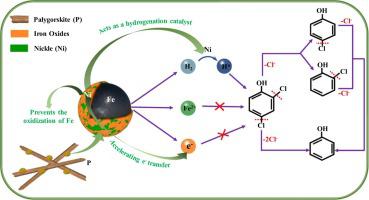当前位置:
X-MOL 学术
›
Environ. Technol. Innov.
›
论文详情
Our official English website, www.x-mol.net, welcomes your
feedback! (Note: you will need to create a separate account there.)
Enhanced dechlorination of 2,4-dichlorophenol using nanorod palygorskite-loaded Fe/Ni nanoparticles: Performance evaluation, influencing factors and action mechanism of Fe and Ni
Environmental Technology & Innovation ( IF 6.7 ) Pub Date : 2023-11-24 , DOI: 10.1016/j.eti.2023.103452 Ebenezer Nestle Asamoah , Hong Liu , Xianyuan Fan
Environmental Technology & Innovation ( IF 6.7 ) Pub Date : 2023-11-24 , DOI: 10.1016/j.eti.2023.103452 Ebenezer Nestle Asamoah , Hong Liu , Xianyuan Fan

|
The basic structural unit of palygorskite (P) consists of rod-shaped crystals with a diameter ranging from 20 to 70 nm. However, due to strong hydrogen bonding and electrostatic forces, most palygorskite rod crystals tend to aggregate, limiting its nanomaterial properties in practical application. To address this limitation, the study focused on dissociating palygorskite aggregates and incorporating them into nanorod palygorskite-loaded Fe/Ni bimetallic nanoparticles (nP-nFe/Ni) synthesis. This approach facilitated the dissociation of palygorskite aggregates and enabled the dispersion of Fe/Ni nanoparticles by palygorskite nanorods. The results revealed that the BET specific surface area of nP-nFe/Ni was significantly higher at 86.17 m/g compared to 33.62 m/g for nFe/Ni. Consequently, the dechlorination efficiency of nP-nFe/Ni for 2,4-dichlorophenol (2,4-DCP) at 120 min was 22.4% higher than that of nFe/Ni, despite nP-nFe/Ni containing only 35.1% of the Fe content found in nFe/Ni at the same dosage. Moreover, it was observed that acidic conditions favor maximum dichlorination, while higher temperatures enhance the dechlorination rate. The action mechanism of Fe was identified as the generation of H, which is catalyzed by Ni to form active hydrogen (H*) that attack the C-Cl bonds of 2,4-DCP for hydrodechlorination. Ni played a vital role in catalyzing H conversion to H* , accelerating H production by Fe, and inhibiting Fe passivation. These findings are crucial for the application of nano iron technology and nano-scale palygorskite in water and wastewater treatment.
中文翻译:

纳米棒负载Fe/Ni纳米棒增强2,4-二氯苯酚脱氯:Fe、Ni的性能评价、影响因素及作用机制
坡缕石(P)的基本结构单元由直径为20至70 nm的棒状晶体组成。然而,由于强氢键和静电力,大多数凹凸棒石棒状晶体易于聚集,限制了其纳米材料在实际应用中的性能。为了解决这一限制,该研究重点是解离坡缕石聚集体并将其纳入纳米棒坡缕石负载的铁/镍双金属纳米颗粒(nP-nFe/Ni)合成中。这种方法促进了凹凸棒石聚集体的解离,并使凹凸棒石纳米棒分散了Fe/Ni纳米颗粒。结果表明,nP-nFe/Ni 的 BET 比表面积明显更高,为 86.17 m/g,而 nFe/Ni 的 BET 比表面积为 33.62 m/g。因此,nP-nFe/Ni 在 120 分钟对 2,4-二氯苯酚 (2,4-DCP) 的脱氯效率比 nFe/Ni 高 22.4%,尽管 nP-nFe/Ni 只含有 35.1% 的氯。相同剂量下 nFe/Ni 中的 Fe 含量。此外,据观察,酸性条件有利于最大限度地二氯化,而较高的温度则提高脱氯率。 Fe的作用机制被认为是生成H,在Ni的催化下形成活性氢(H*),攻击2,4-DCP的C-Cl键进行加氢脱氯。 Ni在催化H转化为H*、加速Fe产氢以及抑制Fe钝化方面发挥着至关重要的作用。这些发现对于纳米铁技术和纳米坡缕石在水和废水处理中的应用至关重要。
更新日期:2023-11-24
中文翻译:

纳米棒负载Fe/Ni纳米棒增强2,4-二氯苯酚脱氯:Fe、Ni的性能评价、影响因素及作用机制
坡缕石(P)的基本结构单元由直径为20至70 nm的棒状晶体组成。然而,由于强氢键和静电力,大多数凹凸棒石棒状晶体易于聚集,限制了其纳米材料在实际应用中的性能。为了解决这一限制,该研究重点是解离坡缕石聚集体并将其纳入纳米棒坡缕石负载的铁/镍双金属纳米颗粒(nP-nFe/Ni)合成中。这种方法促进了凹凸棒石聚集体的解离,并使凹凸棒石纳米棒分散了Fe/Ni纳米颗粒。结果表明,nP-nFe/Ni 的 BET 比表面积明显更高,为 86.17 m/g,而 nFe/Ni 的 BET 比表面积为 33.62 m/g。因此,nP-nFe/Ni 在 120 分钟对 2,4-二氯苯酚 (2,4-DCP) 的脱氯效率比 nFe/Ni 高 22.4%,尽管 nP-nFe/Ni 只含有 35.1% 的氯。相同剂量下 nFe/Ni 中的 Fe 含量。此外,据观察,酸性条件有利于最大限度地二氯化,而较高的温度则提高脱氯率。 Fe的作用机制被认为是生成H,在Ni的催化下形成活性氢(H*),攻击2,4-DCP的C-Cl键进行加氢脱氯。 Ni在催化H转化为H*、加速Fe产氢以及抑制Fe钝化方面发挥着至关重要的作用。这些发现对于纳米铁技术和纳米坡缕石在水和废水处理中的应用至关重要。






























 京公网安备 11010802027423号
京公网安备 11010802027423号